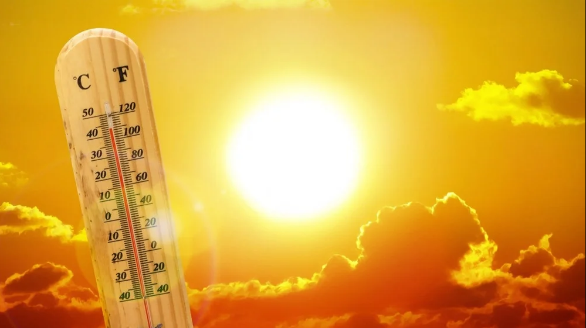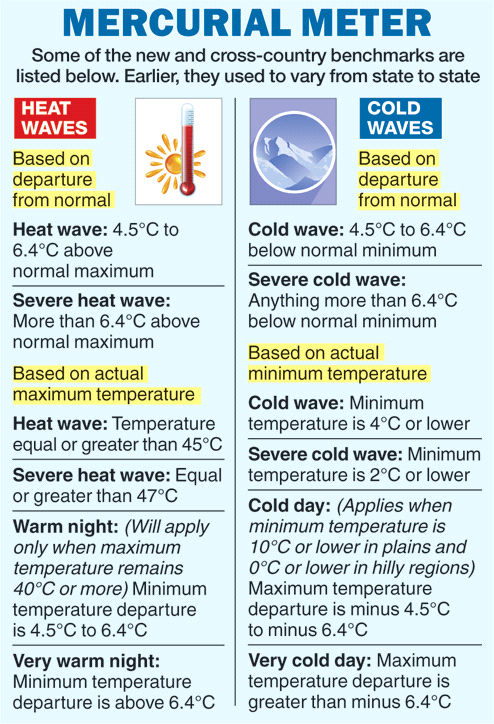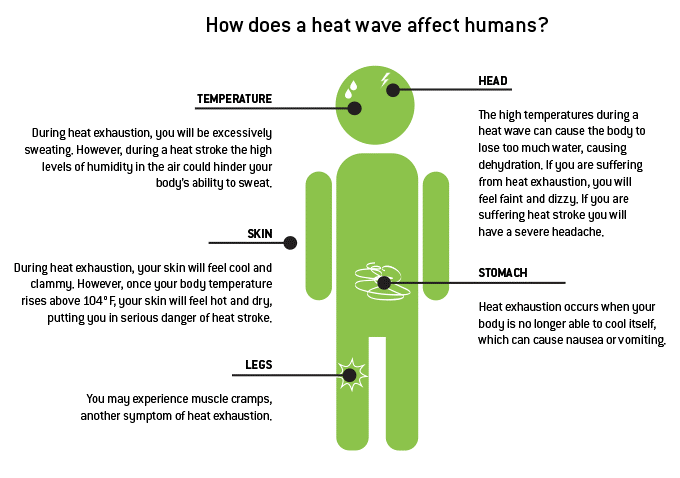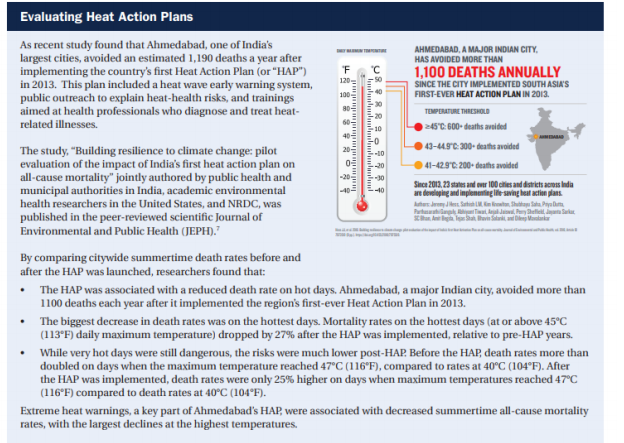Description

Disclaimer: Copyright infringement not intended.
Context
- Heatwaves during March-May are likely in most parts of India, except for the northeastern States- India Meteorological Department (IMD).
Findings of the IMD
- In the week of February 21, the India Meteorological Department (IMD) warned that the maximum temperatures over northwest, west, and central India would be 3-5° C higher than the long-term average.
- On February 21 itself, the national capital recorded its third hottest February day (33.6° C) in more than five decades.
.jpeg)
El Niño + Heat waves
- Heat waves are expected to become more intense, longer, and more frequent over the Indian subcontinent.
- Spring (March-April) in 2022 in India was already a sign of things to come: the heat wave ‘season’ started early, was more intense than the long-term average, and had more waves.
- The 2022 heatwave season was also unusual because the heat waves extended much further south into peninsular India due to a north-south pressure pattern set up by the La Niña.
What is a Heat Wave?
- A heat wave is a period of abnormally and uncomfortably hot and usually humid weather.
- According to the World Meteorological, a heat wave is when the daily maximum temperature for more than five consecutive days exceeds the average maximum temperature by 9 degrees Fahrenheit.
Heat wave Criteria:
- In India, Heatwave is considered if the maximum temperature of a station reaches at least 40 degrees C or more for the Plains and at least 30 degrees C or more for Hilly regions.

Based on Departure from Normal
- Heat Wave:Departure from normal is 4.5 degree C to 6.4 degree C
- Severe Heat Wave: Departure from normal is >6.4 degree C
Based on Actual Maximum Temperature
- Heat Wave: When actual maximum temperature ≥ 45 degree C
- Severe Heat Wave: When actual maximum temperature ≥47 degree C
Warm Night
- It should be considered only when maximum temperature remains 40 degree C or more. It
- may be defined based on departures or actual minimum temperatures as follows:
- Warm night: minimum temperature departure is 4.5 degree C to 6.4 degree C
- Very warm night: minimum temperature departure is >6.4 degree C
Criteria for describing Heat Wave for coastal stations
- When maximum temperature departure is 4.5 degree C or more from normal, Heat Wave may be declared provided actual maximum temperature is 37 degree C or more.
How do heat waves form?
- A heat wave is formed when static high pressure generated in the upper atmosphere over a region for several days up to several weeks.
- This static high pressure generates a hot mass of air, which is stagnant for many days and week, which resulted the trapping of more heat that also reduce the convention currents.
- The high pressure acts as a barrier and forces the mass of air to sink to the surface of the land that prevents heat to rise.
- This hot mass of air accumulates only heat and humidity without any trace of precipitation that causes abnormally high temperatures. It is very often during the summer season, from May to November in the northern hemisphere.
- The seal keeps out convection currents that form clouds and eventually rain clouds, both of which would help the area affected cool off.
- Instead the result is a heat wave that has both high heat and high humidity near the ground.
- These heat waves can last from days to weeks.
Formation of Heat Waves [In Indian Context]
A study published on February 20, 2023, in Nature Geoscience offers some clues as to how different processes contribute to the formation of a heat wave. (The following explanation adapts the study’s findings to the Indian context.)
- In spring, India typically has air flowing in from the west-northwest. This direction is bad news for India for several reasons. In the context of climate change, the Middle East is warming faster than other regions in latitudes similarly close to the equator, and serves as a source of the warm air that blows into India.
- Likewise, air flowing in from the northwest rolls in over the mountains of Afghanistan and Pakistan, so some of the compression also happens on the leeward side of these mountains, entering India with a bristling warmth.
- The air flowing in over the oceans is expected to bring cooler air, since land warms faster than the oceans (because the heat capacity of land is much lower). Alas, the Arabian Sea is warming faster than most other ocean regions.
- Next, the strong upper atmospheric westerly winds that come in from the Atlantic Ocean over to India during spring control the near-surface winds. Any time winds flow from the west to the east, we need to remember that the winds are blowing faster than the planet itself, which is also rotating from west to east. The energy to run past the earth near the surface, against the surface friction, can only come from above. This descending air compresses and warms up to generate some heat waves.
- Finally, the so-called lapse rate – the rate at which temperatures cool from the surface to the upper atmosphere – is declining under global warming. In other words, global warming tends to warm the upper atmosphere faster than the air near the surface. This in turn means that the sinking air is warmer due to global warming, and thus produces heat waves as it sinks and compresses.
- Given these are the processes that contribute to the formation of a heat wave, and the ways in which global warming affects them, it must be clear why once-a-decade heat wave events have started to occur once every few years, and are also more intense. The area covered by these heat waves is also influenced by the background pressure patterns set up by El Niño and La Niña events, and of late it has been expanding.
Other Factors
- The other factors that affect the formation of heat waves are the age of the air mass and how far it has travelled. The north-northwestern heatwaves are typically formed with air masses that come from 800-1,600 km away and are around two days old. Heat waves over peninsular India on the other hand arrive from the oceans, which are closer (around 200-400 km) and are barely a day old. As a result, they are on average less intense.
- In sum, heat waves have a sophisticated anatomy with important implications for how well we can predict them. Nonetheless, early-warning systems can take advantage of the processes, modes of formation, location, and age of the air mass to improve the quality of warnings and also increase how soon they can be issued.

Implications of Heat Waves
Social impacts
- Extreme heat can lead to heat-related illness and death, particularly in elderly populations, the poor, outdoor workers, and in urban areas.
- Heat waves exacerbate the urban heat island effects, amplifying temperatures in built environments, and resulting in poorer air quality due to the creation of ozone that negatively impacts health.
- Heat-related mortality is expected to be higher in cities, particularly those characterized by high population density, inequalities, limited access to health care, high pollution levels and fewer green spaces.
Economic impacts
- Multiple areas of the economic sector experience reduced worker productivity during heatwaves, especially agriculture and construction.
- Globally, 2% of total working hours is projected to be lost every year, either because it is too hot to work or because workers have to work at a slower pace.
- Lost productivity from heat stress at work, particularly in developing countries, is expected to be valued at $4.2 trillion dollars per year by 2030, driving more inequality.
- The agricultural sector, where 940 million people earn their livelihood, is set to be harder hit by hotter temperatures, pushing workers, crops and livestock past their physiological heat and drought tolerances.
- This will result in lost labour, in smaller harvests for farmers, higher prices for consumers, and negative impacts on livelihoods.
- A World Bank report suggests that by 2050, about 600 million Indians will live in places that could experience loss of living standards, which could cost 2.8% of the GDP, stalling efforts to pull large parts of the population out of poverty.
- Increasing energy demand for cooling also comes as an extensive economic cost to residents, businesses, and governments.
- With these extreme heat events, the need for access to cooling should be viewed as a basic necessity – not just for health and productivity reasons but, in some cases, even for survival.
Ecological impacts
- Heatwaves, without concomitant increases in precipitation, can lead to water shortages and increased stress for plants, particularly in arid regions.
- This has the effect of reducing plant growth, the basis of energy production and the food chain, with an overall drying-out of the landscape.
- For example, the 2003 European heatwave resulted in a 10% loss in glacier mass in Europe, which was five-times more than the average annual loss.
- Similar impacts were reported for the French Alps in 2019.
- Over time, such deep permafrost warming and thawing could cause landslides and rock falls, continuing the negative ecological impacts.

How long can a heatwave spell last?
- A heatwave spell generally lasts for a minimum of four days.
- On some occasions, it can extend up to seven or ten days.
- The longest recorded heatwave spell, in recent years, was between 18 – 31 May 2015.
- This spell had severely affected parts of West Bengal along with Odisha, Andhra Pradesh, and Telangana.
- A similar spell in 2014 was reported during June 2 – June 11.
Does all of India experience heat wave conditions?
- Heatwaves are common over the Core Heatwave Zone (CHZ) — Rajasthan, Punjab, Haryana, Chandigarh, Delhi, West Madhya Pradesh, Uttar Pradesh, Chhattisgarh, Orissa, Vidarbha in Maharashtra, parts of Gangetic West Bengal, Coastal Andhra Pradesh and Telangana, as categorised by India Meteorological Department.
- Several recent studies indicate that CHZ experience more than six heatwave days per year during these four months.
- Many places in the northwest and cities along southeastern coast report eight heatwave days per season.
- However, the regions in the extreme north, northeast and southwestern India are lesser prone to heatwaves.
Why India is experiencing more Heat Waves?
- Magnified effect of paved and concrete surfaces in urban areas and a lack of tree cover.
- Urban heat island effects can make ambient temperatures feel 3 to 4 degrees more than they are.
- Higher daily peak temperatures and longer, more intense heat waves are becoming increasingly frequent globally due to climate change.
Mitigation and Adaptation Strategies
- The Mitigation and Adaptation Strategies are intended to mobilise individuals and communities to help protect their neighbours, friends, relatives, and themselves against avoidable health problems during spells of very hot weather.
- The Government agencies need to play a critical role in preparing and responding to heatwaves at a local level,working closely with health and other related departments on a long term strategic plan.
- Establish Early Warning System and Inter-Agency Coordination to alert residents on predicted high and extreme temperatures. Who will do what, when, and how is made clear to individuals and units of key departments, especially for health.
- Capacity building/training programme for health care professionals at the local level to recognize and respond to heat-related illnesses, particularly during extreme heat events.
- These training programmes should focus on medical officers, paramedical staff and community health staff so that they can effectively prevent and manage heat-related medical issues to reduce mortality and morbidity.
- Public Awareness and community outreach- Disseminating public awareness messages on how to protect against the extreme heatwave through print, electronic and social media and Information, Education and Communication materials such as pamphlets, posters and advertisements and Television Commercials on Do and Don’t and treatment measures for heat-related illnesses.
- Collaboration with non-government and civil society to improve bus stands, build temporary shelters, wherever necessary, improve water delivery systems in public areas and other innovative measures to tackle Heatwave conditions.
- Identifying heat hot spots through appropriate tracking of meteorological data and promoting timely development and implementation of local Heat Action Plans with strategic inter-agency coordination, and a response which targets the most vulnerable groups.
- Review of existing occupational health standards, labour laws and sectoral regulations for worker safety in relation to climatic conditions.
- Policy intervention and coordination across three sectors health, water and power are necessary.
- Expedite the rollout of the National Action Plan on Climate Change and Health.
- Preventing temperature-related morbidity and mortality could be a key programme under this mission.
- Ensure an adequate supply of water. Timely access to drinking water can help mitigate this escalation.
- Further research using sub-district level data to provide separate indices for urban and rural areas to enable more targeted geographical interventions.
- Provision of public messaging (radio, TV),mobile phone-based text messages, automated phone calls and alerts.
- Promotion of traditional adaptation practices, such as staying indoors and wearing comfortable clothes.
- Popularisation of simple design features such as shaded windows, underground water storage tanks and insulating housing materials.
- Advance implementation of local Heat Action Plans, plus effective inter-agency coordination is a vital response that the government can deploy to protect vulnerable groups.

|
PRACTICE QUESTION
Q) Which of the following factor/factors plays a role in the formation of Heat Waves?
a. Age of the Air Mass.
b. La Nina.
c. High pressure in the middle layers of the atmosphere.
d. How far the air mass has travelled.
I. a and c
II. c and d
III. a, c and d
IV.All of the above.
Answer: Option IV
|

https://www.thehindu.com/sci-tech/science/explained-imd-is-already-sensing-heat-waves-what-are-they-and-why-do-they-happen/article66556185.ece













